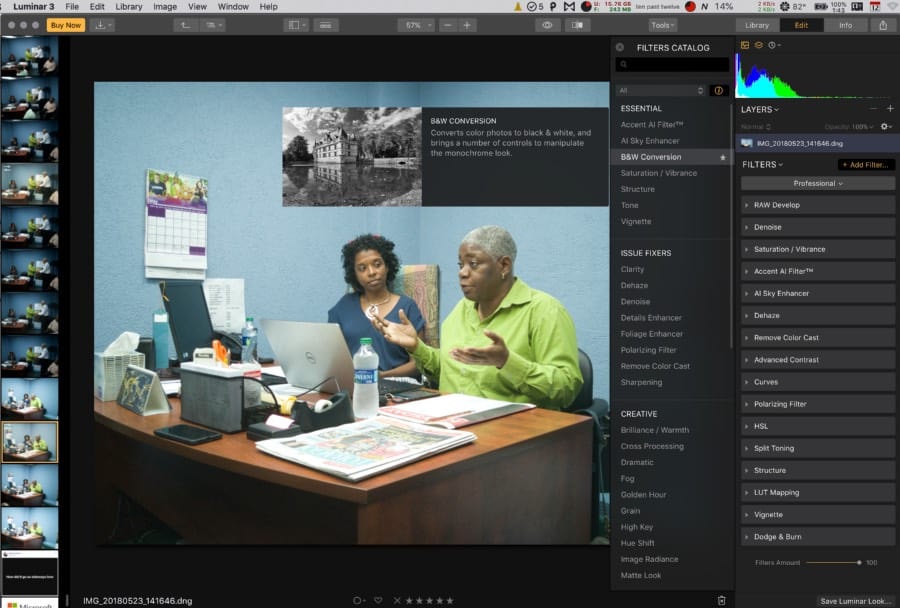
Above: Luminar’s full screen interface and filter suite.
The newest version of Luminar, the third in less than two years, adds useful media management capabilities to the photo editor, which has been in rapid development since its introduction by Skylum, formerly MacPhun, a developer of Photoshop plug-ins and single purpose image editing tools.
Current owners of Luminar 2018 get an upgrade to this new version for free, while the curious can take advantage of a discount on a copy until December 18, when it will be formally launched.
I’ve been looking at replacements for Adobe’s Photoshop and Lightroom products as the gap between current versions on the CC plan widens from the versions I own, the final CS6 editions of both products.
With an increasing profile of DNG files from smartphones in my archives, I need to be sure that a currently developed product can open all my RAW files, regardless of source and Luminar has kept pace with current versions of these captures from a range of sources.
If you’ve been using Photoshop for a long time, you will find Luminar’s way of doing things a bit confusing, though if you are coming to photo adjustment for the first time, it’s likely to make a lot more sense.
Luminar makes its adjustments on layers by default, and brings a quite overwhelming number of them to the table.
If anything, this cornucopia of possibility can be a setback, and I’d suggest creating a custom profile of filters with just the basics, then adding in filters on an as-needed basis. It’s easy to do and brings both order and personalisation to your experience with the software.
When you select a filter to add to your custom profile, you get a useful preview of its effect at the extreme end of its capabilities and a brief text description of how it can improve your images.
Skylum, along with many other image adjustment products, is increasingly making use of rapidly developing Artificial Intelligence technologies to add ever smarter filters to its product.
Just a few weeks ago, Luminar 2018 got a remarkable sky enhancement filter that works so well I may never draw another horizon path ever again.
The big new feature in Luminar 3 is an image asset function, which earns it the extended name Luminar with Libraries.
As with its approach to image adjustment, which is built on layers and selective masking, the asset management is built into Luminar in a distinctly nonstandard way and takes some getting used to if you’re coming from Bridge, a stand-alone browser or Lightroom, which separates image adjustment from culling and editing image assets in different modules.
You can add entire folders to Luminar 3 by importing an entire folder (really a reference to a folder), or you can grab a single image in Quick Edit mode, which creates a temporary reference panel on the left of the editing window during your image adjustment session.
If you’re just getting started with a shoot, Luminar 3 can import images from your card to a designated folder and preview them in that pane.
The RAW Develop filter is where you would start with your edits, layering adjustments on top of your base image. Skylum staked its claim among photographers with its image editing plug-ins, but it’s clear that those were stepping stones toward Luminar and recently the company released a suite of presets for Luminar that offer the capabilites of Tonality, another step in consolidating its past successes into the new product.
The new asset manager is a useful addition to Luminar, and while there’s no question that it makes working with a folder of images much easier, it’s very much a version 1.0 product.
You can flag images, apply stars and colour tags and I successfully dragged an image from the Quick Edit pane to another running app to open it, but the Info pane is woefully deficient, showing only basic EXIF info.
The next step for the Libraries addition needs to be the addition of at least basic IPTC information and the ability to edit it dynamically for Luminar to become more of a one-stop shop for a working photographer.
And Luminar is very much a photographer’s tool, with a filter suite and interface that’s focused on making images look their best.
Available for Windows and Macintosh at a regular price of US$70 and a pre-order cost of $49 until December 18, 2018, it’s competing with a few months of Adobe’s photographer’s plan versus a full license for Skylum’s competitor. And if you already own Luminar 2018, the price, at zero dollars, is an absolute no-brainer.



